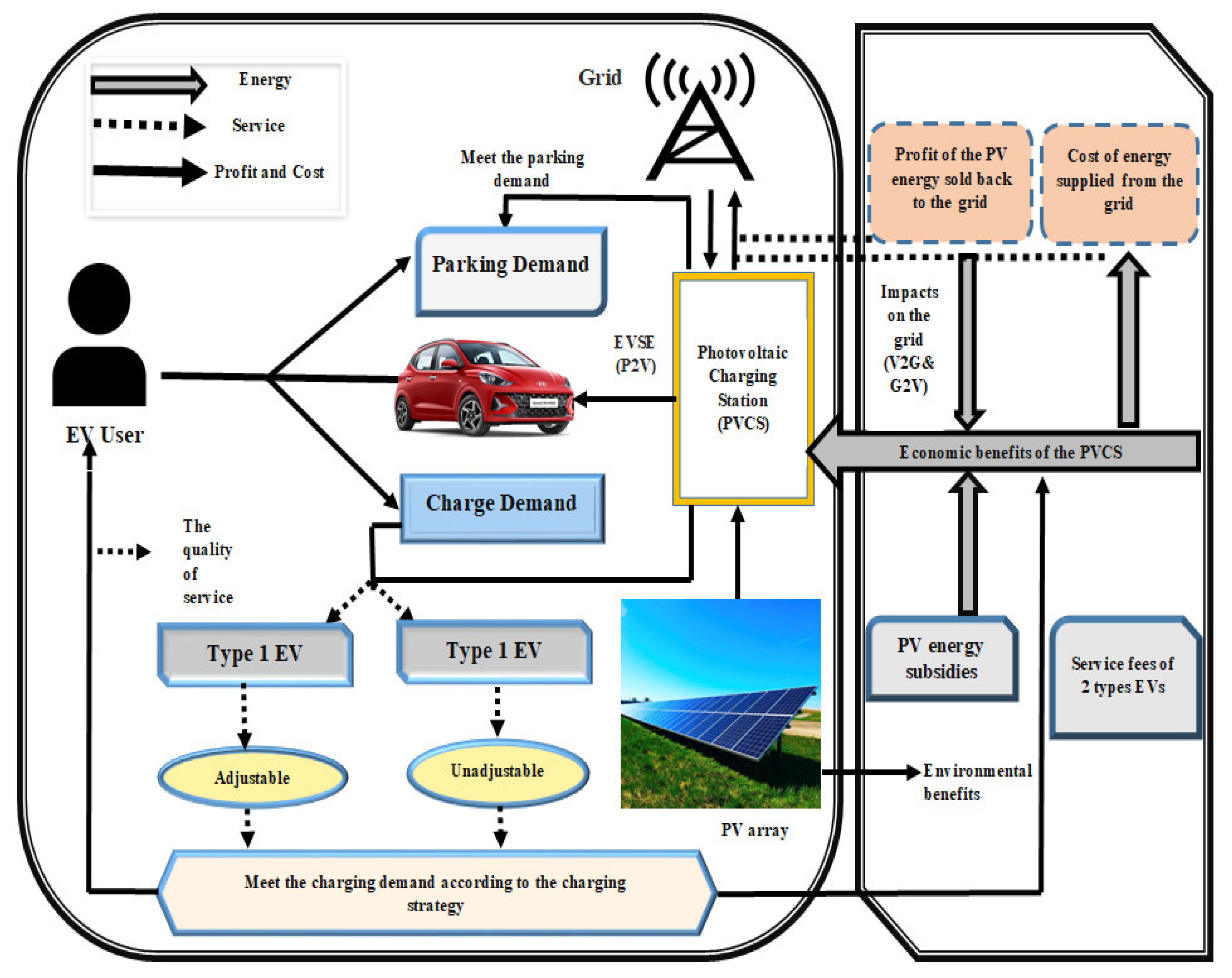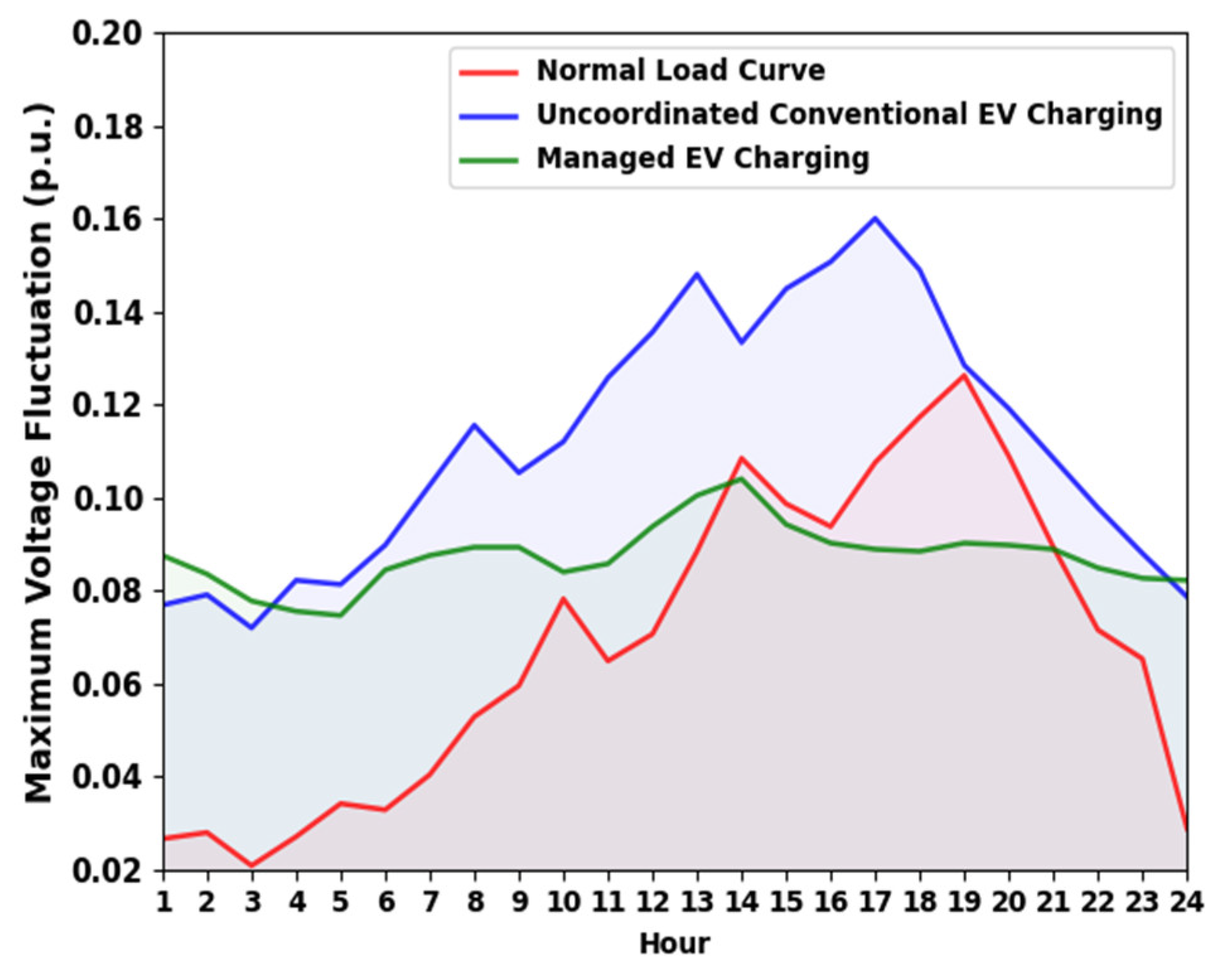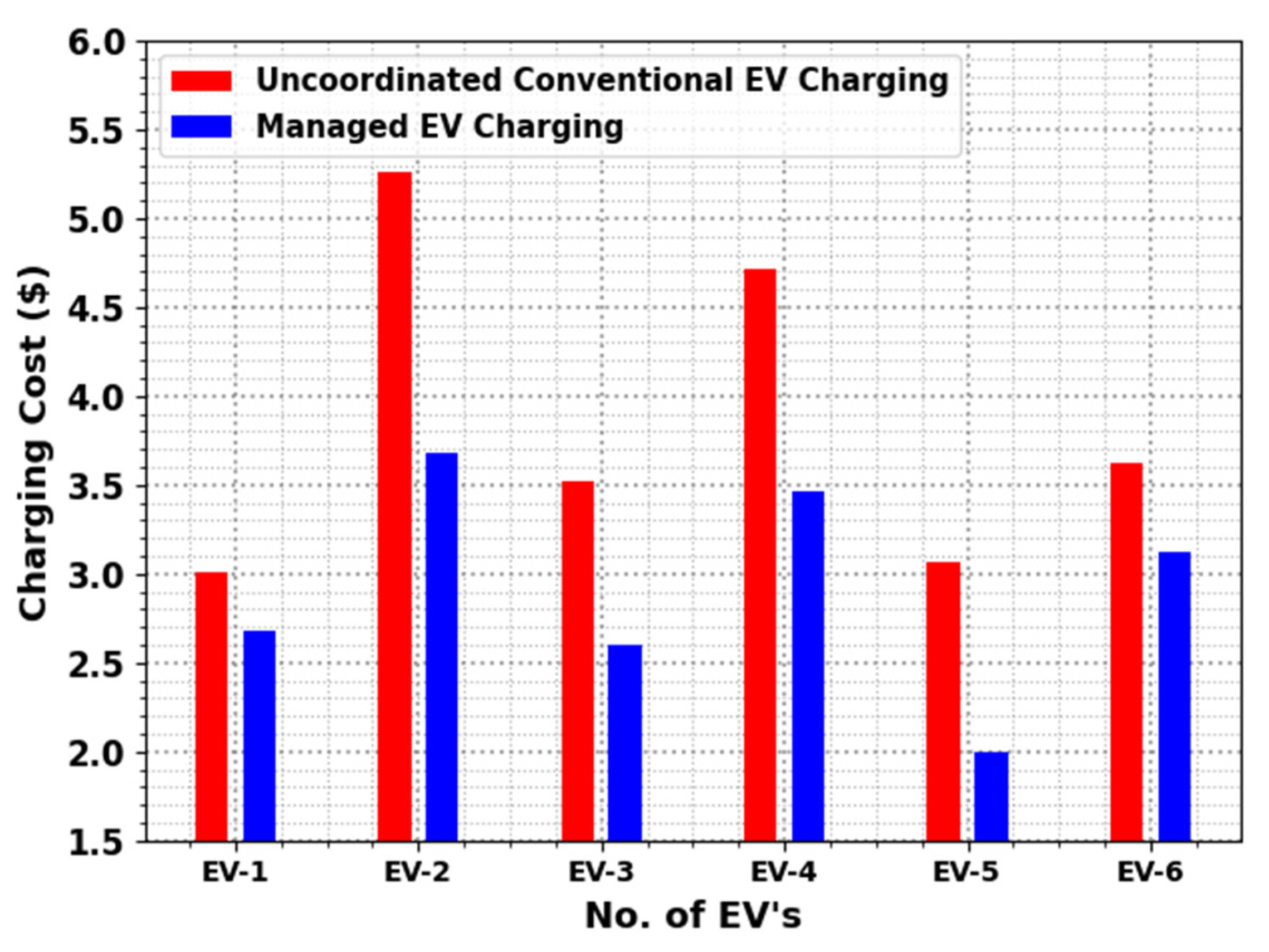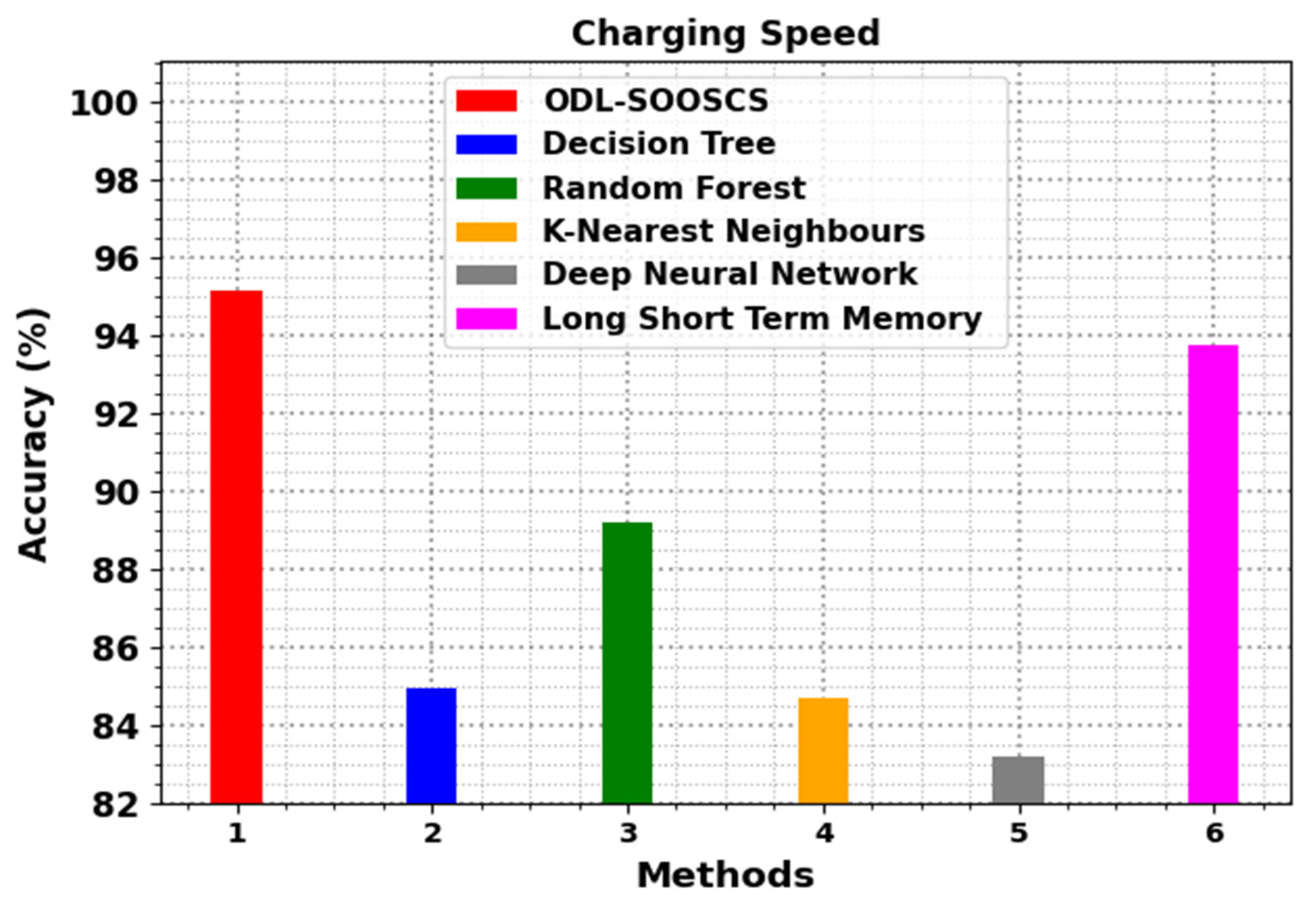Design of Metaheuristic Optimization with Deep-Learning-Assisted Solar-Operated On-Board Smart Charging Station for Mass Transport Passenger Vehicle
Abstract
1. Introduction
2. Related Works
3. The Proposed Model
3.1. System Model
3.2. Modeling of DBN for On-Board Smart Charging
3.3. Hyperparameter Tuning
| Algorithm 1: Pseudo code of BSO algorithm |
| Input: : the number of individuals (birds) : the maximal number of iterations : the frequency of flight behaviours of birds : the probability of foraging for food 1, : five constant parameters ; Initialise the population and describe the relevant parameters Assess the individuals’ fitness values, and identify the optimal solution While If For If rand Birds forage for food Else Birds keep vigilance End if End for Else Split the swarm into 2 parts: scroungers and producers. For If is a producer Producing Else Scrounging End if End for End if Assess novel solutions If the novel solutions are superior to their previous ones, upgrade them Identifies the current optimal solution |
- Arbitrarily begin the description for the population of
- Compute the opposite population of as:
- Select an count of optimum solutions in the union of for the procedure of a novel population.
4. Results and Discussion
5. Conclusions
Author Contributions
Funding
Institutional Review Board Statement
Informed Consent Statement
Data Availability Statement
Conflicts of Interest
References
- Clairand, J.M.; Guerra-Terán, P.; Serrano-Guerrero, X.; González-Rodríguez, M.; Escrivá-Escrivá, G. Electric vehicles for public transportation in power systems: A review of methodologies. Energies 2019, 12, 3114. [Google Scholar] [CrossRef]
- Mastoi, M.S.; Zhuang, S.; Munir, H.M.; Haris, M.; Hassan, M.; Usman, M.; Bukhari, S.S.H.; Ro, J.S. An in-depth analysis of electricvehicle charging station infrastructure, policy implications, and future trends. Energy Rep. 2022, 8, 11504–11529. [Google Scholar] [CrossRef]
- Kumar, A.; Terang, P.P.; Bali, V. Sustainable Solution for Load Forecasted EHV Charging Station in Smart Cities. In Green Internet of Things for Smart Cities; CRC Press: Boca Raton, FL, USA, 2021; pp. 147–156. [Google Scholar] [CrossRef]
- Veerappampalayam, E.S.; Subramani, N.; Subramanian, M.; Meckanzi, S. Handcrafted deep-feature-based brain tumor detection and classification using mri images. Electronics 2022, 11, 4178. [Google Scholar] [CrossRef]
- Hemavathi, S.; Shinisha, A. A study on trends and developments in electric vehicle charging technologies. J. Energy Storage 2022, 52, 105013. [Google Scholar] [CrossRef]
- Zamani, M.; Nagrial, M.; Rizk, J.; Hellany, A. Electric Vehicles Charging: Review of Current Status. In Proceedings of the 2018 Australasian Universities Power Engineering Conference (AUPEC), Auckland, New Zealand, 27–30 November 2018; pp. 1–5. [Google Scholar] [CrossRef]
- Kumar, K.; Kumar, J.; Vs, S.N. Standards for electric vehicle charging stations in India: A review. Energy Storage 2022, 4, e261. [Google Scholar] [CrossRef]
- Gönül, Ö.; Duman, A.C.; Güler, Ö. Electric vehicles and charging infrastructure in Turkey: An overview. Renew. Sustain. Energy Rev. 2021, 143, 110913. [Google Scholar] [CrossRef]
- Savari, G.F.; Sathik, M.J.; Raman, L.A.; El-Shahat, A.; Hasanien, H.M.; Almakhles, D.; Aleem, S.H.A.; Omar, A.I. Assessment of charging technologies, infrastructure and charging station recommendation schemes of electric vehicles: A review. Ain Shams Eng. J. 2022, 14, 101938. [Google Scholar] [CrossRef]
- Wahid, M.R.; Budiman, B.A.; Joelianto, E.; Aziz, M. A review on drive train technologies for Passenger Electric Vehicles. Energies 2021, 14, 6742. [Google Scholar] [CrossRef]
- Goswami, A.; Sadhu, P.K. Stochastic firefly algorithm enabled fast charging of solar hybrid electric vehicles. Ain Shams Eng. J. 2021, 12, 529–539. [Google Scholar] [CrossRef]
- Lodi, C.; Gil-Sayas, S.; Currò, D.; Serra, S.; Drossinos, Y. Full-battery effect during on-board solar charging of conventional vehicles. Transp. Res. Part D Transp. Environ. 2021, 96, 102862. [Google Scholar] [CrossRef]
- Murat, A.K.I.L.; Dokur, E.; Bayindir, R. Energy Management for EV Charging Based on Solar Energy in an Industrial Microgrid. In Proceedings of the 2020 9th International Conference on Renewable Energy Research and Application (ICRERA), Glasgow, UK, 27–30 September 2020; pp. 489–493. [Google Scholar] [CrossRef]
- Chavhan, S.; Zeebaree, S.R.; Alkhayyat, A.; Kumar, S. Design of Space Efficient Electric Vehicle Charging Infrastructure Integration Impact on Power Grid Network. Mathematics 2022, 10, 3450. [Google Scholar] [CrossRef]
- Shariff, S.M.; Alam, M.S.; Ahmad, F.; Rafat, Y.; Asghar, M.S.J.; Khan, S. System design and realization of a solar-powered electric vehicle charging station. IEEE Syst. J. 2019, 14, 2748–2758. [Google Scholar] [CrossRef]
- Sain, C.; Banerjee, A.; Biswas, P.K.; Padmanaban, S. A state-of-the-art review on solar-powered energy-efficient PMSM drive smart electric vehicle for sustainable development. In Advances in Greener Energy Technologies; Springer: Singapore, 2020; pp. 231–258. [Google Scholar] [CrossRef]
- Nisha, K.S.; Gaonkar, D.N.; Jayalakshmi, N.S. Operation and control of multiple electric vehicle load profiles in bipolar microgrid with photovoltaic and battery energy systems. J. Energy Storage 2023, 57, 106261. [Google Scholar] [CrossRef]
- Mohammed, S.S.; Titus, F.; Thanikanti, S.B.; Sulaiman, S.M.; Deb, S.; Kumar, N.M. Charge Scheduling Optimization of Plug-In Electric Vehicle in a PV Powered Grid-Connected Charging Station Based on Day-Ahead Solar Energy Forecasting in Australia. Sustainability 2022, 14, 3498. [Google Scholar] [CrossRef]
- Rachel, D.; Mahesh, K.R.K. Solar Powered Off-Board Smart Charging Station for Electric Vehicles based on Artificial Neural Network Technology. Int. J. Mech. Eng. 2022, 7, 272–281. [Google Scholar]
- Dairi, A.; Zerrouki, N.; Harrou, F.; Sun, Y. EEG-Based Mental Tasks Recognition via a Deep Learning-Driven Anomaly Detector. Diagnostics 2022, 12, 2984. [Google Scholar] [CrossRef]
- Veeramani, T.; Bhatia, S.; Hussain Memon, F. Design of fuzzy logic-based energy management and traffic predictive model for cyber physical systems. Comput. Electr. Eng. 2022, 102, 108135. [Google Scholar] [CrossRef]
- Metwally, A.M.; Gupta, M.S. Metaheuristics with Deep Transfer Learning Enabled Detection and classification model for industrial waste management. Chemosphere 2022, 308, 136046. [Google Scholar] [CrossRef]
- Alotaibi, Y.; Alghamdi, S.; Khalafand, O.I.; Nanda, A.K. Improved Metaheuristic-Driven Energy-Aware Cluster-Based Routing Scheme for IoT-Assisted Wireless Sensor Networks. Sustainability 2022, 14, 7712. [Google Scholar] [CrossRef]
- Parthiban, S.; Harshavardhan, A.; Neelakandan, S.; Prashanthi, V.; Alhassan Alolo, A.R.A.; Velmurugan, S. Chaotic Salp Swarm Optimization-Based Energy-Aware VMP Technique forCloud Data Centers. Comput. Intell. Neurosci. 2022, 2022, 4343476. [Google Scholar] [CrossRef]
- Arul Vinayakam Rajasimman, M.; Manoharan, R.K.; Aridoss, M.; Galety, M.G. Robust Facial Expression Recognition Using An Evolutionary Algorithm with a Deep Learning Model. Appl. Sci. 2023, 13, 468. [Google Scholar] [CrossRef]
- Raghavendra, S.; Neelakandan, S.; Prakash, M.; Geetha, B.T.; Asha, S.M.R.; Roberts, M.K. Artificial Humming Bird with Data Science Enabled Stability Prediction Model for Smart Grids. Sustain. Comput. Inform. Syst. 2022, 36, 100821. [Google Scholar] [CrossRef]
- Geetha, B.T.; Kumar, P.S.; Bama, B.S.; Neelakandan, S.; Dutta, C.; Babu, D.V. Green energy aware and cluster-based communication for future load prediction in IoT. Sustain. Energy Technol. Assess. 2022, 52, 102244. [Google Scholar] [CrossRef]
- Perumal, S.K.; Kallimani, J.S.; Ulaganathan, S.; Bhargava, S.; Meckanizi, S. Controlling energy aware clustering and multihop routing protocol for IoT assisted wireless sensor networks. Concurr. Comput. Pract. Exper. 2022, 34, e7106. [Google Scholar] [CrossRef]
- Mishra, K.; Majhi, S.K. A binary bird swarm optimization-based load balancing algorithm for cloud computing environment. Open Comput. Sci. 2021, 11, 146–160. [Google Scholar] [CrossRef]
- Ekinci, S.; Hekimoğlu, B.; Izci, D. Opposition based Henry gas solubility optimization as a novel algorithm for PID control of DC motor. Eng. Sci. Technol. Int. J. 2021, 24, 331–342. [Google Scholar] [CrossRef]
- Shibl, M.; Ismail, L.; Massoud, A. Electric vehicles charging management using machine learning considering fast charging and vehicle-to-grid operation. Energies 2021, 14, 6199. [Google Scholar] [CrossRef]
- Subbulakshmi, P.; Ramalakshmi, V. Honest auction based spectrum assignment and exploiting spectrum sensing data falsification attack using stochastic game theory in wireless cognitive radio network. Wirel. Pers. Commun. 2018, 102, 799–816. [Google Scholar] [CrossRef]
- Ambeth Kumar, V.D.; Malathi, S.; Abhishek, K.; Kalyana, C.V. Active volume control in smart phones based on user activity and ambient noise. Sensors 2020, 20, 4117. [Google Scholar] [CrossRef]
- Chithambaramani, R. An efficient applications cloudinteroperability framework using i-anfis. Symmetry 2021, 13, 268. [Google Scholar] [CrossRef]
- Ramalingam, C. addressing semantics standards for cloud portability and interoperability in multi cloud environment. Symmetry 2021, 13, 317. [Google Scholar] [CrossRef]
- Rajaram, P.V. Intelligent deep learning based bidirectional long short term memory model for automated reply of e-mail client prototype. Pattern Recognit. Lett. 2021, 152, 340–347. [Google Scholar] [CrossRef]
- Paulraj, D.; Ezhumalai, P. A deep learning modified neural network (dlmnn) based proficient sentiment analysis technique on twitter data. J. Exp. Theor. Artif. Intell. 2022. [Google Scholar] [CrossRef]
- Satpathy, S.; Padthe, A.; Trivedi, M.C.; Goyal, V.; Bhattacharyya, B.K. Method for measuring supercapacitor’s fundamental inherent parameters using its own self-discharge behavior: A new steps towards sustainable energy. Sustain. Energy Technol. Assess. 2022, 53, 102760. [Google Scholar] [CrossRef]
- Ranjith, C.P.; Hardas, B.M.; Mohideen, M.S.K.; Raj, N.N.; Robert, N.R. Robust deep learning empowered real time object detection for unmanned aerial vehicles based surveillance applications. J. Mob. Multimed. 2022, 19, 451–476. [Google Scholar] [CrossRef]
- Subramani, N.; Mardani, A.; Mishra, A.R.; Ezhumalai, P. A fuzzy logic and DEEC protocol-based clustering routing method for wireless sensor networks. AIMS Math. 2023, 8, 8310–8331. [Google Scholar] [CrossRef]
- Revanesh, M.; Sridhar, V.; Acken, J.M. CB-ALCA: A cluster-based adaptive lightweight cryptographic algorithm for secure routing in wireless sensor networks. Int. J. Inf. Comput. Secur. 2019, 11, 637–662. [Google Scholar] [CrossRef]
- Hardas, B.M. Optimization of peak to average power reduction in OFDM. J. Commun. Technol. Electron. 2017, 62, 1388–1395. [Google Scholar] [CrossRef]
- Pokle, S.B. Analysis of OFDM system using DCT-PTS-SLM based approach for multimedia applications. Clust. Comput. 2019, 22, 4561–4569. [Google Scholar] [CrossRef]









| Efficiency (%) | |||
|---|---|---|---|
| Hour | Normal Load Curve | Uncoordinated Conventional EV Charging | Managed EV Charging |
| 1 | 92.21 | 89.44 | 91.29 |
| 2 | 90.69 | 87.97 | 89.78 |
| 3 | 90.65 | 87.93 | 89.74 |
| 4 | 90.01 | 87.31 | 89.11 |
| 5 | 90.97 | 88.24 | 90.06 |
| 6 | 91.03 | 88.30 | 90.12 |
| 7 | 91.09 | 88.36 | 90.18 |
| 8 | 85.61 | 83.04 | 84.75 |
| 9 | 89.56 | 86.87 | 88.66 |
| 10 | 89.19 | 86.51 | 88.30 |
| 11 | 85.68 | 83.11 | 84.82 |
| 12 | 88.66 | 86.00 | 87.77 |
| 13 | 85.45 | 82.89 | 84.60 |
| 14 | 88.66 | 86.00 | 87.77 |
| 15 | 85.14 | 82.59 | 84.29 |
| 16 | 86.29 | 83.70 | 85.43 |
| 17 | 87.27 | 84.65 | 86.40 |
| 18 | 93.88 | 91.06 | 92.94 |
| 19 | 93.37 | 90.57 | 92.44 |
| 20 | 91.60 | 88.85 | 90.68 |
| 21 | 93.77 | 90.96 | 92.83 |
| 22 | 91.71 | 88.96 | 90.79 |
| 23 | 92.09 | 89.33 | 91.17 |
| 24 | 92.83 | 90.05 | 91.90 |
| Maximum Voltage Fluctuation (p.u.) | |||
|---|---|---|---|
| Hour | Normal Load Curve | Uncoordinated Conventional EV Charging | Managed EV Charging |
| 1 | 0.0266 | 0.0768 | 0.0875 |
| 2 | 0.0279 | 0.0790 | 0.0835 |
| 3 | 0.0208 | 0.0719 | 0.0777 |
| 4 | 0.0270 | 0.0822 | 0.0755 |
| 5 | 0.0341 | 0.0813 | 0.0746 |
| 6 | 0.0328 | 0.0897 | 0.0844 |
| 7 | 0.0404 | 0.1026 | 0.0875 |
| 8 | 0.0528 | 0.1155 | 0.0893 |
| 9 | 0.0595 | 0.1053 | 0.0893 |
| 10 | 0.0782 | 0.1120 | 0.0839 |
| 11 | 0.0648 | 0.1257 | 0.0857 |
| 12 | 0.0706 | 0.1355 | 0.0937 |
| 13 | 0.0884 | 0.1480 | 0.1004 |
| 14 | 0.1084 | 0.1333 | 0.1039 |
| 15 | 0.0986 | 0.1449 | 0.0942 |
| 16 | 0.0937 | 0.1506 | 0.0902 |
| 17 | 0.1075 | 0.1600 | 0.0888 |
| 18 | 0.1173 | 0.1489 | 0.0884 |
| 19 | 0.1262 | 0.1284 | 0.0902 |
| 20 | 0.1088 | 0.1191 | 0.0897 |
| 21 | 0.0893 | 0.1084 | 0.0888 |
| 22 | 0.0715 | 0.0977 | 0.0848 |
| 23 | 0.0653 | 0.0879 | 0.0826 |
| 24 | 0.0288 | 0.0786 | 0.0822 |
| Charging Cost (USD) | ||
|---|---|---|
| No. of EV’s | Uncoordinated Conventional EV Charging | Managed EV Charging |
| EV-1 | 3.010043 | 2.682354 |
| EV-2 | 5.261121 | 3.679667 |
| EV-3 | 3.522947 | 2.59687 |
| EV-4 | 4.719723 | 3.465957 |
| EV-5 | 3.067032 | 1.998482 |
| EV-6 | 3.622678 | 3.124021 |
| Charging Station | ||
|---|---|---|
| Methods | Accuracy (%) | Accuracy Change (%) |
| ODL-SOOSCS | 97.12 | −0.00 |
| Decision Tree | 78.12 | −16.81 |
| Random Forest | 86.97 | −9.13 |
| Long Short-Term Memory | 94.52 | −0.54 |
| Charging Speed | ||
|---|---|---|
| Methods | Accuracy (%) | Accuracy Change (%) |
| ODL-SOOSCS | 95.12 | 0 |
| Decision Tree | 84.95 | −0.32 |
| Random Forest | 89.21 | −1.2 |
| K-Nearest Neighbor | 84.68 | −0.65 |
| Deep Neural Network | 83.19 | −2.54 |
| Long Short-Term Memory | 93.72 | −0.98 |
| Efficiency (%) | |||
|---|---|---|---|
| Hour | Managed EV Charging—10 (%) GWN | Managed EV Charging—15 (%) GWN | Managed EV Charging—20 (%) GWN |
| 1 | 93.13 | 92.73 | 92.10 |
| 2 | 93.40 | 92.89 | 92.20 |
| 3 | 94.90 | 94.22 | 93.62 |
| 4 | 93.85 | 93.33 | 92.73 |
| 5 | 93.32 | 92.57 | 91.84 |
| 6 | 93.98 | 93.48 | 92.86 |
| 7 | 93.35 | 92.75 | 92.00 |
| 8 | 93.62 | 92.83 | 92.10 |
| 9 | 93.74 | 93.15 | 92.47 |
| 10 | 94.40 | 94.16 | 93.53 |
| 11 | 93.40 | 92.81 | 92.08 |
| 12 | 94.64 | 94.19 | 93.50 |
| 13 | 93.96 | 93.56 | 92.90 |
| 14 | 94.09 | 93.52 | 92.74 |
| 15 | 93.02 | 92.38 | 91.66 |
| 16 | 93.24 | 92.63 | 92.02 |
| 17 | 93.85 | 93.61 | 92.83 |
| 18 | 94.24 | 93.53 | 92.89 |
| 19 | 94.04 | 93.27 | 92.67 |
| 20 | 94.82 | 94.52 | 93.73 |
| 21 | 93.52 | 93.20 | 92.51 |
| 22 | 93.87 | 93.61 | 92.82 |
| 23 | 94.01 | 93.22 | 92.57 |
| 24 | 93.99 | 93.45 | 92.81 |
Disclaimer/Publisher’s Note: The statements, opinions and data contained in all publications are solely those of the individual author(s) and contributor(s) and not of MDPI and/or the editor(s). MDPI and/or the editor(s) disclaim responsibility for any injury to people or property resulting from any ideas, methods, instructions or products referred to in the content. |
© 2023 by the authors. Licensee MDPI, Basel, Switzerland. This article is an open access article distributed under the terms and conditions of the Creative Commons Attribution (CC BY) license (https://creativecommons.org/licenses/by/4.0/).
Share and Cite
Justin, S.; Saleh, W.; Lashin, M.M.A.; Albalawi, H.M. Design of Metaheuristic Optimization with Deep-Learning-Assisted Solar-Operated On-Board Smart Charging Station for Mass Transport Passenger Vehicle. Sustainability 2023, 15, 7845. https://doi.org/10.3390/su15107845
Justin S, Saleh W, Lashin MMA, Albalawi HM. Design of Metaheuristic Optimization with Deep-Learning-Assisted Solar-Operated On-Board Smart Charging Station for Mass Transport Passenger Vehicle. Sustainability. 2023; 15(10):7845. https://doi.org/10.3390/su15107845
Chicago/Turabian StyleJustin, Shekaina, Wafaa Saleh, Maha M. A. Lashin, and Hind Mohammed Albalawi. 2023. "Design of Metaheuristic Optimization with Deep-Learning-Assisted Solar-Operated On-Board Smart Charging Station for Mass Transport Passenger Vehicle" Sustainability 15, no. 10: 7845. https://doi.org/10.3390/su15107845
APA StyleJustin, S., Saleh, W., Lashin, M. M. A., & Albalawi, H. M. (2023). Design of Metaheuristic Optimization with Deep-Learning-Assisted Solar-Operated On-Board Smart Charging Station for Mass Transport Passenger Vehicle. Sustainability, 15(10), 7845. https://doi.org/10.3390/su15107845





